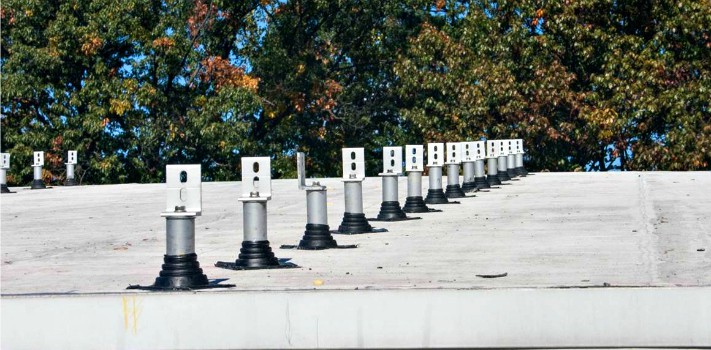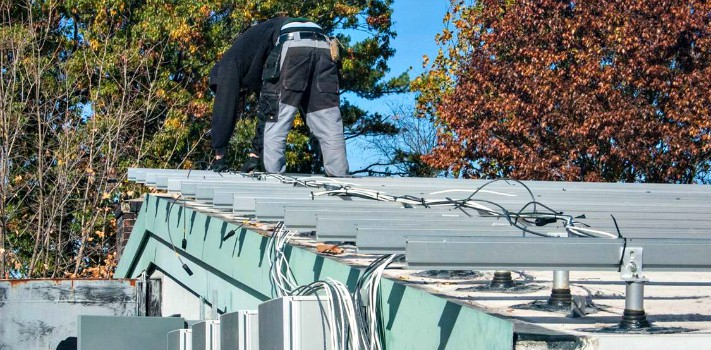Greenburgh Hebrew Center (Dobbs Ferry, NY) Installs Solar Panels
What have we done and what are we doing to the earth we inhabit?
Story
On Yom Kippur, 2010, Rabbi Barry Kenter stood before his congregation at Greenburgh Hebrew Center (GHC) in Dobbs Ferry, NY and delivered an important message.
“Yizkor is our time of rememberance,” he said. “What have we done and what are we doing to the earth we inhabit?”
He urged the members of his congregation, as Jews on this of reflection, to reevaluate their relationship with the natural world and embrace their role as caretakers of the earth. He also noted that many aspects of traditional Jewish life, in particular Shabbat and the Shema, promote ecological consciousness by mandating a pause in consumption and acknowledging the interconnections of all things.
Finally, he shared his dream: that GHC become a beacon of sustainability and environmental stewardship.
“Who knows? Maybe someday we’ll have a solar powered ner tamid!” he said.
He never imagined that this dream would come true so soon, and so spectacularly. Just three years after Rabbi Kenter delivered his Yom Kippur sermon, GHC installed 200 solar panels on its roof.
Building solar panels on site enabled GHC to save money, cut its contributions to the climate crisis, express its commitment to the Jewish values of stewardship, and set an early example for families and other congregations.
So how did they do it?
Getting started on a solar installation project isn’t always easy. Many roofs are old or structurally unsound, which makes them poor candidates for solar panels. Purchasing a solar energy system outright can be expensive. Furthermore, non-profits aren’t eligible to benefit from some of the tax incentives offered to businesses and individuals.
Determined to overcome these hurdles, Rabbi Kenter assembled a green team that devised a plan and gathered support from congregants and processional staff.
The green team then solicited offers from solar installers and chose the one that best fit their needs. After selecting the installer, a lawyer on GHC’s board negotiated a power purchase agreement (PPA), a common arrangement for solar installations. Under the terms of the PPA, the solar company owns and maintains the solar panels, but it sells the electricity produced by the panels to GHC at a price below that charged by the local utility. The agreement provides GHC with the option to buy the system after a number of years. IF GHC purchases it, the energy generated by the system would be nearly free (excluding basic maintenance costs).
The installer designed the system and completed several tests to make sure that GHC’s roofs would be able to hold the weight of the solar panels. The installer then applied for government incentives and building permits.
The process of installation was so visible that everyone in the GHC community had a chance to see it. People excitedly popped in and out of the building to track the project’s progress, anxiously awaiting its completion.
200 solar panels were installed in GHC’s roof, along with transformers, wiring, and a meter. Then the installer arranged for inspections by the local Department of Building and Utility. The solar energy system was connected to the local electricity grid so that any electricity that GHC didn’t need could be sold to the utility.
The system, worth $150,000, was installed at no cost to GHC because of the PPA agreement.
GHC’s solar panels are capable of generating 50 kilowatts of electricity, enough to light 500, 100-watt light bulbs. The panels meet more than half of GHC’s annual electricity demand, reducing the congregation’s electricity bill by 50% and saving between $7,000 and $9,00 per year.
Rabbi Kenter found that solar energy not only reduced GHC’s electricity bills, it also shifted its culture. “Installing solar energy is a way in which we can have people become much more aware of nature, sustainability, and making a difference in the world,” he said.
Rabbi Kenter advises institutions interested in going to solar to “be patient and focused.” He emphasized the importance of getting congregants and staff involved, noting, ” the more people who feel a sense of ownership of the project and see value in it, the better it will be.”
The solar panels have become a source of pride and a visible symbol of the congregation’s commitment to sustainability.
At a celebration ceremony for the center’s new solar energy system in November 2013, local politicians congratulated the congregation, Rabbi Kenter spoke about the importance of reducing the congregation’s carbon footprint, and Janet Leuchter, GHC’s cantor, led the group in songs about the sun.
Click here to see Greenburgh Hebrew Center’s solar panels at work.
Jewish Values
When you build a new house, you shall make a parapet for your roof, so that you do not bring bloodguilt on your house if anyone should fall from it. (Deuteronomy 22:8)
In this verse in Deuteronomy, the Torah offers a early, concise building safety code.
In the Talmud, the rabbis interpret this commandment to mean that we should remove all sources of danger from our property. For example, a building owner should put a barrier around a ditch, cave or trench. The principle is that we should be proactive, anticipate potential dangers, and take action before someone is harmed.
The dangers considered by the rabbis were clear and obvious. But if we want to fulfill this commandment today, we need to consider dangers that they could not have imagined. One of these dangers is energy consumption: the fossil fuels we use in our buildings for lighting, heating, and cooling.
Residential and commercial sectors account for around 40% of the energy we use in the US. Most of it comes from coal, oil, and gas. When these fossil fuels are burned to create energy, they release greenhouse gases that contribute to climate change — and the harmful droughts, floods, and heatwaves that accompany it.
We need energy to run our buildings, and many of us feel we have no choice but to use energy from fossil fuels. But fortunately there is something we can do. We can reduce the danger from burning fossil fuels by installing solar energy systems — on our roofs and our properties — that generate energy without harming the planet. Solar energy can be our modern day parapet.
Education Ideas
- Make solar cookers out of boxes and aluminum foil to discover the power of the sun’s energy.
- Learn about Birkat HaChamah, the ritual of blessing of the sun that occurs every 28 years.
- Encourage families to conduct home energy efficiency audits during Hanukkah, the holiday that celebrates the importance of renewable energy through the story of the olive oil that lasted for eight days.
More Project Ideas
- Educational Signs: Surprise Lake Camp created an “education kiosk” next to the electricity meter on the gym building which has solar panels on the roof. Signs explain how the solar system works.
- Fundraising: Ramapo for Children’s solar energy system was installed by a vendor under a PPA agreement with no upfront cost. But the camp used the opportunity to raise money for operating costs. A board member made a donation to cover the first year of payments for the electricity generated by the system.
- Starting with Solar Thermal: The JCC of Staten Island installed a solar thermal system that provides hot water in the building. The solar thermal system was a great first step towards an even larger project completed in 2014: a 103 kW solar photovoltaic system that produces electricity to power the building. At the time of its installation, the solar panel system became the largest solar energy installation on a non-profit in Staten Island and one of the largest in all of New York City.
- Solar Ner Tamid: The facilities manager at Temple Israel Center White Plains rewired the ner tamid, the traditional eternal light in its chapel, to a solar panel. By day, the light is powered directly by the sun; at night, it draws on energy stored in a battery.
Resources
For more resources, go to our greening resources page and look under the Energy Efficiency & Solar tab.







